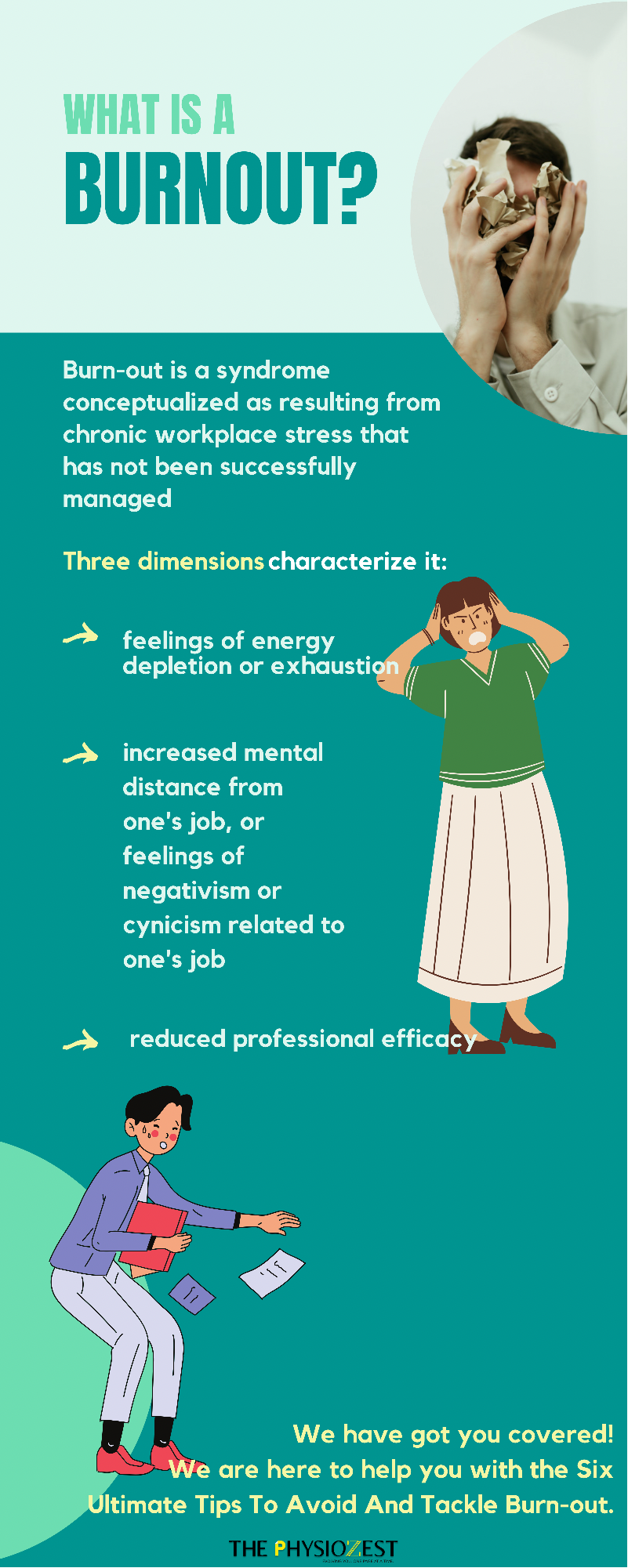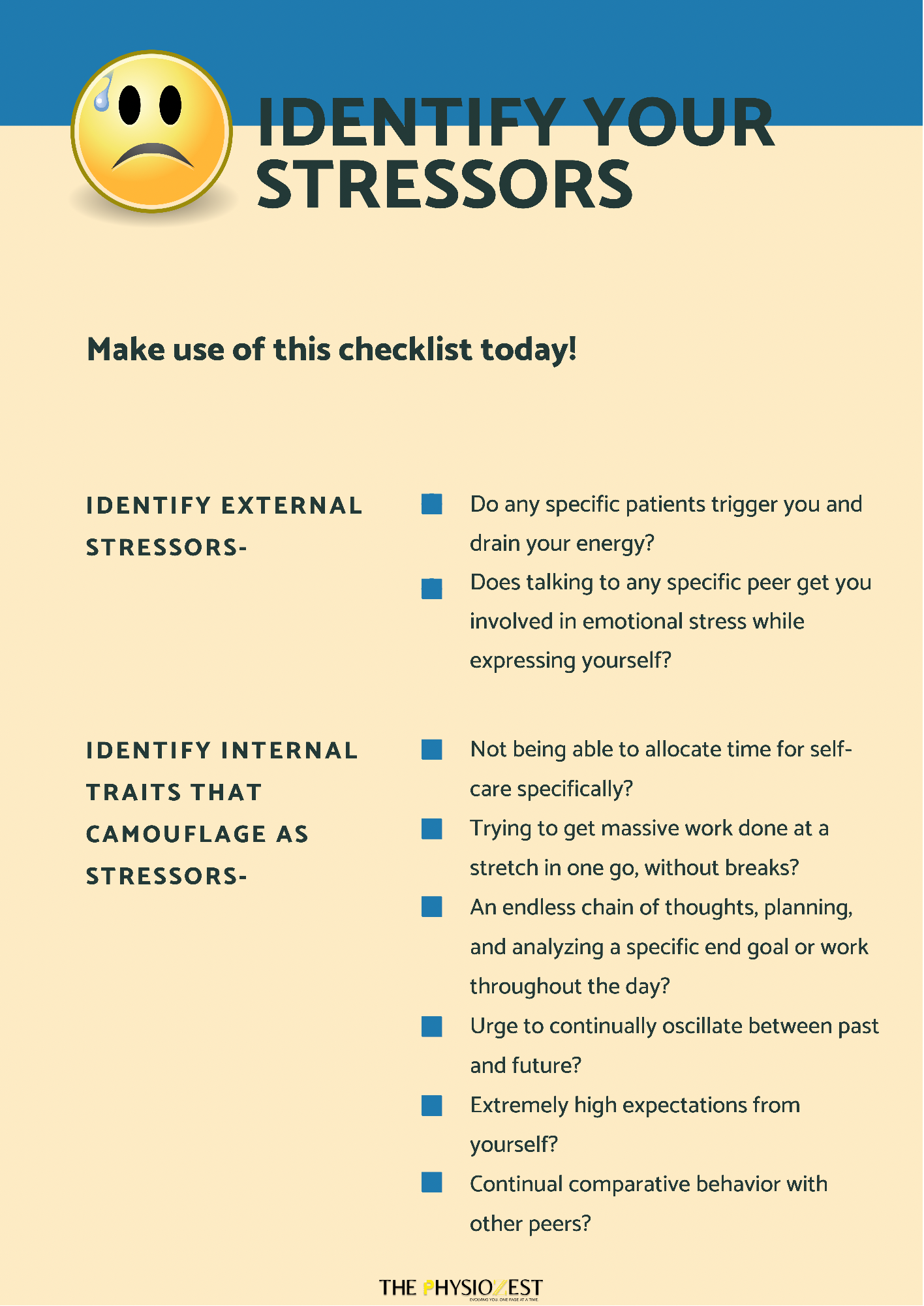
8.5 min read | Reboot Lifestyle
6 Ways to Overcome Burnout as a Physical Therapist
Written by Jessica Gomes, Aashi Sethiya
Graphics by Nimisha More
Visual Media by Nimisha More
Audio by Aparna Premraj, Natasja Azad
Peek into :
“Burn-out isn’t a setback in your career, but a catalyst to get the best out of you.”
Activity: Take this test to know if you are a burned-out physical therapist.
1. Do you feel overwhelmed while trying to manage your side hustle, outpatient visits, and primary day job?
2. Find it challenging to concentrate and achieve your professional goals?
3. Do you feel exhausted and have lost the zeal to work for several days even after getting good sleep?
5. Has your work performance potentially decreased?
6. Ever thought that you wouldn’t be able to continue with Physiotherapy forever?
Remember how keen and enthusiastic you were in PT school to start working professionally and never imagined being burned out that even the thought of pulling through this service for years to come has become dreadful.
If the answer is yes, you might be experiencing a burn-out. A study by the APTA academy of education in 2020 stated that 67.8% of physical therapists reported work as the most significant burn-out source. 1
WHO in the ICD-11 (International Classification of Diseases) defines burnout as:

A Physical therapist’s responsibilities involve a lot of physical and mental labor. A spike in caseloads can have us running from one patient to the next, which take a toll on our job performance.3
We have got you covered!
We are here to help you with the Six Ultimate Tips To Avoid And Tackle Burn-out.
1. Identify your Stressors
”We make a living by what we get, but we make a life by what we give.”
Reread the quote.
This quote by Winston Churchill holds so true to our physiotherapy profession. We give joy to our patients by making them functionally independent, and this makes our life meaningful! Being burned out results in disturbances in psycho-social and physical domains which reduces the efficacy of a therapist in treating their patients. Identifying the stressors can break down this never-ending cycle.
Make use of this checklist today!

2. Optimize your Stressors
The shared cultural belief of stress is that it is “bad for me.” This valuation leads to an urge to reduce or avoid stress. However, multiple lines of research link the experience of stress with beneficial outcomes. Research published by the American Psychological Association states an alternative approach—stress optimization. As an intervention, stress optimization guides individuals towards implementing regulation tactics consistent with optimizing stress responses to achieve valued ends instead of merely reducing or avoiding stress.
In doing so, shifting the valuation of stress from
“is bad for me” to “can be good for me.”
Stress optimization can be achieved through the following strategies.
1. Situation Selection
Select situations (regardless of the stress they might cause) that create opportunities to grow, learn, and experience. Subject yourself to strenuous training to prepare for a task rather than avoid it. If you are treating a complicated case, and even if the work to be done seems like a heap of stones, do not stress just thinking about it. Just go for it—one step at a time.
2. Attentional Deployment
An individual can attend to the underlying opportunities associated with the stress rather than focusing on the negative aspects. For example, suppose you face an impending exam rather than focusing on how the pressure you feel is uncomfortable. In that case, you can focus on the fact that you are stressed because performing well on the exam is essential to you and devote more attentional resources toward achieving this goal.
3. Cognitive Change
Reappraisal processes represent a broad array of strategies in which individuals can alter their thoughts to regulate their stress. For instance, rather than attempting to reappraise a situation in a way that makes it seems less stressful, you can employ reappraisal tactics to change perceptions of the stressor into positive ones (e.g., “I have what it takes to manage this diagnosis) (e.g., viewing piling demands as evidence of a positive trajectory)
4. Response Modulation
This refers to modifying behavioral, physiological, and psychological stress responses after stress is experienced. Ask yourself a question, ‘what is the worst possible thing that can happen?’ In a complicated patient’s case, the worst thing that can happen might be that the patient might not be satisfied with the treatment and leave your clinic even after doing your best.
Prepare for it. Sometimes you just can’t meet the overtly high expectations of your patients. That does not mean you should stop trying. Just initiate with your work, be patient; things will fall into place, and the burden that seemed prodigious will lessen bit by bit. 4
3. Communicate
Effective clinician-patient communications can:
A study published in 2012 in the Journal of Physiotherapy (Australia) showed a clear link between communication abilities and the “therapeutic alliance.” The study authors noted that “communication is an essential skill,” one that physiotherapists need to master to improve the quality and efficiency of care.6
Our profession demands from us to work in unison within and with other departments of healthcare. You need to be vocal about your doubts. Be prepared before asking your query, research the topic, and refer to different sources. This will show your willingness to know. One might feel intimidated asking senior officials, but this will work to your benefit of treatment further. You have got nothing to lose.
So build up that courage and confidence and ask for help when in need. Reach out to your friends and co-workers. Maybe they might have gone through a similar situation and provide you with the right advice. As human beings, we find solace in knowing that many ones out there are going through similar burned-out experiences.
4. Self Ameliorate
Everyone reacts differently when stress hits. Stress can manifest in many ways leading to anger, frustration, anxiety, depression, and lack of interest in social interaction. We cannot control the situation, but we definitely can control the way we react to it. Incorporate meditation and mindfulness. A study published in the International Journal of Psychiatry in Medicine has shown mindfulness to decrease burnout and improve well-being among healthcare providers.7
“The PhysioZest recommends the reader to have a look at these amazing and short videos to know more about meditation and mindfulness. ”
A study published in the PeerJ in 2015 showed exercise intervention to reduce burnout stress. 8
So practice what you preach!
As Darwin has said, ‘survival of the one adaptable to change’; bring out the necessary changes in you as you encounter every new problem. If you feel that lack of knowing advanced techniques is coming in your way of getting positive outcomes in treatment, enroll yourself in continuing medical education.
Sometimes a break is all you need! Have you been procrastinating plans of going out on holiday? Book that holiday! You will come back rejuvenated to start afresh!
5. Journaling
Being burned out might make you feel overwhelmed all the time. At one point, you may get saturated with thoughts. Penning down all your intertwined thoughts and emotions in a journal will untangle them and create a clear picture. Journaling is cost-effective therapy. Just try it once. You will feel much better, and then you will make journaling a ritual. Not only emotions but also jot down on paper what difficulties you face and the possible causes that are triggering it. If the reason is within you, write down the measures you should take to solve the problem, and if the cause is external, write down how you will react to tackle the situation. Reflect and write what small goals you have achieved and how different and better your next move should be from the previous one.
6. Reviving Focus
One of the many things burnout puts in jeopardy is our focus. Although we wish to complete our projects and professional commitments on time, we are constantly distracted by our phones and thoughts. While we assure ourselves just to have a glance or just check some videos out on the phone, we end up spending a whole lot of time being distracted from work. What comes along is the significant guilt of not completing tasks on time. Nir Eyal, in his inspiring book ‘Indistractable’, mentions some excellent ways to stay focused. One of which is The 10-minute rule to remain focused, which he practices every single day. To know more, check out Nir Eyal’s 4 minutes super impactful video, wherein you will be able to put aside your distractions and revive the sense of accomplishing your work on time.
All said and done, there might be a time when burnout stress affects your personal lives and takes a severe toll on your health. It is never too late to get professional help and learn better coping strategies to get past this burn-out.
So go ahead and implement these 6 strategies in your lives to knock down the burn-out!
Take-Aways:
References:
Share this article
Related Posts






love this article. hits the right note